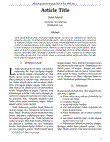Resultados de búsqueda - "Humanism"
Materias dentro de su búsqueda.
Materias dentro de su búsqueda.
- human rights 26
- derechos humanos 23
- Derechos Humanos 17
- 13
- Human rights 12
- Derechos humanos 11
- México 10
- Mexico 9
- Human Rights 7
- Inteligencia Artificial 7
- capital humano 7
- Artificial Intelligence 5
- Capital Humano 5
- education 5
- Derecho 4
- Educación 4
- Education 4
- Español 4
- Human Capital 4
- Human Resources 4
- Law 4
- M12 4
- antioxidantes 4
- artificial intelligence 4
- capital relacional 4
- communication 4
- conservación 4
- conservation 4
- educación 4
- human capital 4
-
341
-
342
-
343
Antibacterial and cytotoxic activities of new sphingolipids and other constituents isolated from Cissus incisa leaves
Publicado 2020“…A cell line of immortalized human hepatocytes (IHH) was included as a control of non-cancerous cells. …”
Enlace del recurso
Artículo -
344
La conducta criminal y su relación con el sistema límbico
Publicado 2023Enlace del recurso
Artículo -
345
-
346
-
347
Ciudades inteligentes y ambientes de comunicación digital
Publicado 2014Enlace del recurso
Artículo -
348
Potential Application of Prebiotics in Aquaculture
Publicado 2019“…It has been documented in a number of terrestrialanimals and humans that microbiota of the gastrointestinal tract plays important roles in affecting the nutrition andhealth of the host. …”
Enlace del recurso
Artículo -
349
-
350
Large genetic distances among Aedes aegypti populations along the South Pacific coast of Mexico
Publicado 2002“…It is likely that dispersal via human commerce in the northeast confounds patterns of natural gene flow.…”
Enlace del recurso
Artículo -
351
Metallophilic fungi research: an alternative for its use in the bioremediation of hexavalent chromium
Publicado 2017“…Contamination by hexavalent chromium has had a large impact on modern society and human health. This problem is a consequence of its great industrial applicability to several products and processes. …”
Enlace del recurso
Artículo -
352
Sperm chromatin dispersion by formaldehyde in Wistar rats
Publicado 2015“…Formaldehyde (FA) is an environmental xenobiotic, which is genotoxic and carcinogenic to humans and animals; it induces DNA damage, mutations, and clastogenicity during critical cytogenetic events. …”
Enlace del recurso
Artículo -
353
Selenium and Sulfur to Produce Allium Functional Crops
Publicado 2017“…Abstract: Selenium is an element that must be considered in the nutrition of certain crops since its use allows the obtaining of biofortified crops with a positive impact on human health. The objective of this review is to present the information on the use of Se and S in the cultivation of plants of the genus Allium. …”
Enlace del recurso
Artículo -
354
Modifications to the delivery of a gross anatomy course during the COVID-19 pandemic at a Mexican medical school
Publicado 2020“…Different technological tools have been used in the gross anatomy course in combination with face-toface classes, but now are forced to move exclusively online. The Human Anatomy Department in the Medical School of the Universidad Autonoma de Nuevo León (UANL) implemented asynchronous sessions as a short-term resolution, transformed to synchronous sessions as the pandemic progressed. …”
Enlace del recurso
Artículo -
355
Nanomaterial-Based Antifungal Therapies to Combat Fungal Diseases Aspergillosis, Coccidioidomycosis, Mucormycosis, and Candidiasis
Publicado 2021“…Aspergillus, Coccidioides, Mucorales (the most common filamentous fungi), and Candida auris (non-filamentous fungus) can cause infections in humans. They are able to cause critical life-threatening illnesses in immunosuppressed individuals, patients with HIV/AIDS, uncontrolled diabetes, hematological diseases, transplantation, and chemotherapy. …”
Enlace del recurso
Artículo -
356
Sources of antibiotics pollutants in the aquatic environment under SARS-CoV-2 pandemic situation
Publicado 2021“…Within this review, an overview of sources of antibiotics to aquatic environments was done along with its impact to the environment and trophic chain, and negative effects of human health due prolonged exposure which endanger the environment, population health, water, and food sustainability. …”
Enlace del recurso
Artículo -
357
Experimental models for hepatitis C virus (HCV): New opportunities for combating hepatitis C
Publicado 2004“…Recently, a system of efficient culture was established that allows replication of subgenomic molecules of HCV in a cell line of human hepatoma. In this revision, after a brief description of the molecular biology, means of transmission and clinical characteristics of hepatitis C, some of the experimental models are described that have been developed to date, focusing mainly on the subgenomic replicon system and their use in the development of new antiviral treatments.…”
Enlace del recurso
Artículo -
358
Factors for manufacturing competitiveness of automotive part suppliers from Nuevo Leon, Mexico: a literature review
Publicado 2017“…These are: quality, product innovation, process technology, qualified capital human, support of the automotive cluster, and information technology. …”
Enlace del recurso
Artículo -
359
AISLAMIENTO DE CEPAS DE BRUCCELLA sp., EN MUESTRAS DE LECHE BOVINA PRODUCIDAS EN FINCAS DEL SECTOR EL DOS DE SOCOPO, ESTADO DE BARINAS, VENEZUELA
Publicado 2010“…Abstract Brucellosis is an important disease transmitted to human; through no pasteurized dairy products. This pathology is caused by the genus Brucella. …”
Enlace del recurso
Artículo -
360
Herder y la sombra de la Ilustración. La formación en el siglo XVIII
Publicado 2021Enlace del recurso
Artículo

